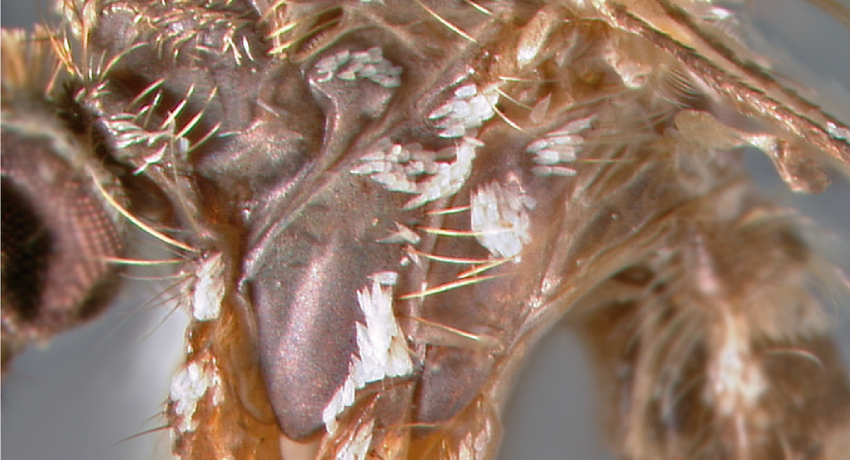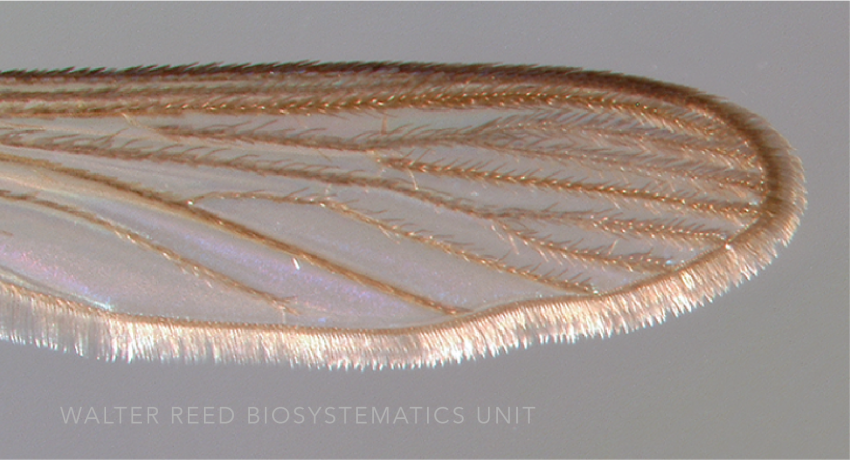AFROTROPICAL & PALEARCTIC REGION
Informal name: One-banded Zimbabwean Typical Mosquito
Etymology: not stated [one banded (L); probably refers to single bands on tibiae]
Culex univittatus exhibits a highly distinctive line of scales marking the position of wing vein 2A. This character is unique—not reported in any other mosquito—and could represent a primitive character of the family Culicidae. Culex univittatus is the nominotypical member of the Univittatus Subgroup, which comprises four species including Cx. fuscocephala Theobald, Cx. neivei Theobald and Cx. perexiguus Theobald. There are four currently recognized synonyms of Cx. univittatus: ataeniatus Theobald, goughii Theobald, montforti Ventrillon, and simplex Theobald. Culex univittatus has been reported in almost every country in Africa, and occurs into the Middle East and Indian subcontinent. Previous reports of Cx. univittatus in Europe are now recognized as pertaining to Cx. perexiguus.
Type locality: Salisbury, Rhodesia [Zimbabwe]
Type depository: Natural History Museum, London, England, United Kingdom (NHMUK)
DIAGNOSTIC CHARACTERS (Click photos to view; mouse over and click large photo to zoom in.)
ADULT (illustrated): Head: Proboscis entirely dark-scaled. Thorax: Postspiracular and prealar scales present; upper and lower mesokatepisternal scale patches separate; lower mesepimeron with one or two setae. Wing: Base of costa with line of pale scales; vein 2A present. Legs: Fe-II with complete anterior pale stripe; Ta-I–III not banded. Abdomen: Terga with basal bands narrow, of even width; abdominal basal pale bands slightly expanded mesally.
LARVA (not illustrated): Head: Seta 1-C stout. Terminal segments: Comb with average of 43 scales; comb scales apically rounded with even fringe of fine spinules; siphon relatively long, index <8.5; seta 1-S shorter than width of siphon, with 5 or 6 pairs of tufts, two lateral; seta 1a-S usually situated in the pecten; seta 1-X with 2–4 branches; pecten spines with 3 lateral denticles; seta 6-VI usually single.
TAXONOMIC KEYS
Harbach 1988
Jupp 1996
Becker et al. 2010
![]()
WRBU – Culex (Cux.) - Afrotropical Region (West Africa) - Adult
![]()
WRBU – Culex (Cux.) - East Palearctic Region – Adult
![]()
WRBU – Culex (Cux.) - East Palearctic Region – Larva
Exemplar DNA sequences
Cx. univittatus COI: KU187056–60, KU380425, LC100115, LC088986–99
BIONOMICS
Due to their close morphology and overlapping distributions, some confusion exists in the correct assignment of bionomic and pathogen associations between Cx. univittatus, Cx. neivai and Cx. perexiguus.
Immatures
Culex univittatus is a ground pool breeder, preferring partially shaded to fully sunlit habitats with filamentous algae present. Typical habitats include fresh water ground pools, marshes, ditches, swamp and stream margins, and animal foot prints. They are rarely collected in larger ground pools. Larvae are highly motile and have been observed leaping up to 3m along the habitat substrate following potential predatory disturbances.
Adults
Females feed all through the night, peaking at about midnight. Although dominantly bird feeders, Cx. univittatus will feed on large mammals, and will enter homes to feed on people. Populations of Cx. univittatus in South Africa are solely zoophagic.
DISTRIBUTION NOTES
Algeria, Angola, Benin, Bulgaria, Burkina Faso, Cameroon, Central African Republic, Congo, Democratic Republic of the Congo, Djibouti, Egypt, Ethiopia, Gabon, Gambia, Ghana, India, Iran, Iraq, Israel (and Gaza Strip & West Bank), Kenya, Kuwait, Lebanon, Liberia, Madagascar (includes Glorioso & Juan De Nova Is), Mali, Mauritania, Morocco, Mozambique, Namibia, Niger, Nigeria, Oman, Pakistan, Qatar, Republic of South Africa, Saudi Arabia, Senegal, Somalia, Sudan & South Sudan, Syria, Tanzania, Tunisia, Turkmenistan, Uganda, Yemen, Zambia, Zimbabwe.

WRBU VECTOR HAZARD REPORTS
VHR: Medically Important Mosquitoes of EUCOM
View other WRBU Vector Hazard Reports
Available GIS Models:
Cx_univittatus_Dornak_1 Africa
IMPORTANT REFERENCES (full citations below)
Theobald 1901c: 29 (M*, F*)
Séguy 1924: Pl. IV (M genitalia*)
Edwards 1941: 306 (M*, F*), 419 (P)
Hopkins 1952: 291 (L*)
Mattingly & Knight 1956: 104 (taxonomy)
Senevet et al. 1957: 52 (M*; taxonomy)
Jupp 1970: 9 (M*, taxonomy)
Aslamkhan 1971b (distribution; Pakistan)
Jupp 1971: 339 (taxonomy)
Jupp 1971 (taxonomy)
Jupp 1972: 103 (M*; taxonomy)
Gutsevich et al. 1974: 385 (M*, F, L*)
White 1975: 316,320 (taxonomy, lectotype designation; distribution)
Sirivanakarn 1976: 48 (M*, F*, P, L*; distribution)
Rodhain et al. 1977 (distribution)
Beier et al. 1986: 164 (distribution)
Harbach 1988: 52 (M*, F, P*, L*; taxonomy, keys, bionomics, distribution)
Suleman et al. 1993 (distribution; Pakistan)
Jupp 1996 (M*, F*; key)
Al-Houty 1997 (checklist Kuwait)
Eritja et al. 2000: 12 (distribution; Spain)
Ribeiro et al. 2002 (distribution; Portugal)
Becker et al. 2010: 329 (F*, L*; key, taxonomy, distribution, bionomics)
Ahmed et al. 2011 (distribution; Saudi Arabia)
Robert et al. 2019 (distribution, Euro-Mediterranean)
CURRENT SYNONYMS
syn. simplex Theobald
1903a: 337 (F*; Heptaphlebomyia). Type locality: Salisbury, Mashonaland [Zimbabwe] (NHMUK).
syn. montforti Ventrillon
1905a: 448 (M*, F; Heptaphleobmyia). Type locality: Ankajobe, Madagascar (NHMUK). References: White 1975: 321 (lectotype designation); Townsend 1990: 106 (type information).
syn. ataeniatus Theobald
1911b: 261 (F). Type locality: Onderstepoort, Transvaal [Republic of South Africa] (NHMUK). References: Edwards 1941: 353 (taxonomy); White 1980: 137 (synonomy).
syn. goughii Theobald
1911b: 268 (syntype F*, only). Type locality: Onderstepoort, Transvaal [Republic of South Africa] (NHMUK). References: White 1975: 320 (taxonomy).
CITED REFERENCES
Ahmed, A.M., Shaalan, E.A., Aboul-Soud, M.A.M., Tripet, F., & Al-Khedhairy, A.A. (2011). Mosquito vectors survey in the Al-Ahsaa district of eastern Saudi Arabia. Journal of Insect Science, 11, 176.
Al-Houty, W. (1997) Checklist of the insect fauna of Kuwait. Kuwait Journal of Science and Engineering, 24(1): 145-162.
Aslamkhan, M. (1971b). The mosquitoes of Pakistan. I. A checklist. Mosquito Systematics, 3(4), 147–159.
Becker, N., Petrić, D., Zgomba, M., Boase, C., Madon, M., Dahl, C., & Kaiser, A. (2010). Mosquitoes and their control (Second ed.). Berlin Heidelberg: Springer-Verlag.
Beier, J.C., Kenawy, M.A., Said, S.E., & Merdan, A.I. (1986). Vector potential of culicine mosquitoes in Faiyum Governorate, Egypt. Journal of the American Mosquito Control Association, 2(2), 164–167.
Edwards, F.W. (1941). Mosquitoes of the Ethiopian Region. III. Culicine adults and pupae. Bulletin of the British Museum (Natural History) Entomology.
Eritja, R., Aranda, C., Padrós, J., Goula, M., Lucientes, J., Escosa, R., . . . Cáceres, F. (2000). An annotated checklist and bibliography of the mosquitoes of Spain (Diptera: Culicidae). European Mosquito Bulletin, 8, 10–18.
Gutsevich, A.V., Monchadskii, A.S., & Shtakel’berg, A.A. (1974). Fauna of the USSR. New series No. 100 Diptera. Vol. III, No. 4. Mosquitoes. Family Culicidae. Jerusalem, Israel: Keter Publishing House Jerusalem Ltd. (Original work published 1971).
Harbach, R.E. (1988). Mosquitoes of the subgenus Culex in southwestern Asia and Egypt (Diptera: Culicidae). Contributions of the American Entomological Institute, 24(1), 1–240.
Hopkins, G.H.E. (1952). Mosquitoes of the Ethiopian region. I. Larval bionomics of mosquitoes and taxonomy of culicine larvae (2nd ed.). London, UK: British Museum (Natural History).
Jupp, P.G. (1970). The taxonomic status of Culex (Culex) univittatus Theobald (Diptera: Culicidae) in South Africa. Mosquito Systematics, 2(1), 9–16.
Jupp, P.G. (1971). The taxonomic status of Culex (Culex) univittatus Theobald (Diptera: Culicidae) in South Africa. Journal of the Entomological Society of South Africa, 34, 339–357.
Jupp, P.G. (1972). A morphological study of Culex (Culex) univittatus Theobald and Culex (Culex) neavei Theobald from various African countries. Mosquito Systematics, 4(4), 103–113.
Jupp, P.G. (1996). Mosquitoes of southern Africa. Culicinae and Toxorhynchitinae. Ekogilde Publishers, Hartebeespoort, South Africa, 156pp.
Mattingly, P.F., & Knight, K.L. (1956). The mosquitoes of Arabia. I. Bulletin of the British Museum (Natural History), 4(3), 89–141.
Robert, V., Günay, F., Le Goff, G., Boussès, P., Sulesco, T., Khalin, A., Medlock, J.M., Kampen, H., Petrić, D. & F. Schaffner. (2019). Distribution chart for Euro-Mediterranean mosquitoes (western Palaearctic region). Journal of the European Mosquito Control Association, 37, 1–28.
Rodhain, F., Boutonnier, A., & Coulanges, P. (1977). Bibliographie des Culicides de Madagascar. Archives des l’Instituts Pasteur de Madagascar, 46, 485–495.
Seguy, E. (1924). Les moustiques de l'Afrique Mineure, de l'Egype et de la Syrie. Encyclopedie Entomologique (A), 1, 1–257.
Senevet, G., Andarelli, L., & Lieutaud, A. (1957). A propos de Culex univittatus Theob. Archives de l'Institut Pasteur d'Algérie, 35, 52–53.
Sirivanakarn, S. (1976). Medical entomology studies - III. A revision of the subgenus Culex in the Oriental region (Diptera: Culicidae). Contributions of the American Entomological Institute, 12(2), 1–272.
Suleman, M., Khan, K., & Khan, S. (1993). Ecology of mosquitoes in Peshawar Valley and adjoining areas: Species composition and relative abundance. Pakistan Journal of Zoology, 25(4), 321–328.
Theobald, F.V. (1901c). A monograph of the Culicidae or mosquitoes (Vol. 2). London: British Museum (Natural History). with Atlas of 37 colored pls. + 5 pls. of photographs.
Theobald, F.V. (1903a). A monograph of the Culicidae of the World (Vol. 3). London: British Museum (Natural History). 359pp
Theobald, F.V. (1911b). The Culicidae or mosquitoes of the Transvaal. Report of the Director of Veterinary Research, 1, 232–272.
Townsend, B.C. (1990). Culicidae. In B.C. Townsend, J.E. Chainey, R.W. Crosskey, A.C. Pont, R.P. Lane, J.P.T. Boorman, & C.A. Crouch (Eds.), A catalogue of the types of bloodsucking flies in the British Museum (Natural History). London: British Museum (Natural History).
Valenzuela, J.G., Pham, V.M., Garfield, M.K., Francischetti, I.M.B., & Ribeiro, J.M.C. (2002). Toward a description of the sialome of the adult female mosquito Aedes aegypti. Insect Biochemistry and Molecular Biology, 32(9), 1101–1122.
Ventrillon, E. (1905a). Culicides nouveaux de Madagascar. Archives de Parasitologie, Paris, 9, 441–450.
White, G.B. (1975). Notes on a catalogue of the Ethiopian Region. Mosquito Systematics, 7(4), 303–344.
White, G.B. (1980). Catalogue of the Culicidae of the Afrotropical region British Museum (Natural History). In R.W. Crosskey, Cogan, B.H., Freeman, P, Pont, A.C., Smith, K.G.V., & Oldroyd, H. (Ed.), Catalogue of the Diptera of the Afrotropical region British Museum (Natural History) (pp. 114–148). London.
CITE THIS PAGE
Walter Reed Biosystematics Unit (Year). Culex univittatus species page. Walter Reed Biosystematics Unit Website, http://wrbu.si.edu/vectorspecies/mosquitoes/univittatus, accessed on [date (e.g. 03 February 2020) when you last viewed the site].











































































































































































